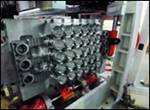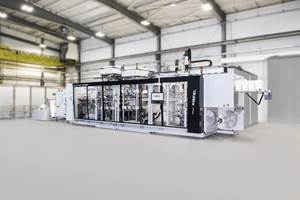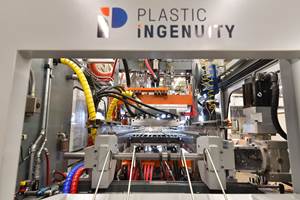K 2007 Thermoforming: Packaging Lines Grow Bigger and Faster
There was plenty of news in thermoforming at K 2007 as suppliers rolled out continuous roll-fed packaging systems with greater output, enhanced cooling, reduced air consumption, and more automation.
There was plenty of news in thermoforming at K 2007 as suppliers rolled out continuous roll-fed packaging systems with greater output, enhanced cooling, reduced air consumption, and more automation. Among them were a high-speed tilt-mold unit, a high-output forming/punching machine, and high-capacity in-line extrusion/forming systems for cups and packaging.
There was also news in tooling, automation, and decorating, including a high-capacity stacker, a novel tooling method to make perforated multi-compartment containers, and an innovative decorating process for PVC and PET blister packaging to replace paperboard. (More exhibits at K were covered previously in our September pre-show report. See Learn More below.)
BIGGER ROLL-FEDS
Germany’s Illig introduced its largest continuous in-line machine yet, the RDK 90, with a forming area of 840 x 670 mm. Claimed to be one of the industry’s fastest machines, it uses special steel-rule die-cutting technology and offers the option to trim inside or outside the tool. Illig developed the machine to compete in U.S. high-volume packaging applications. At the show, the machine produced 4 x 6 mm PET trays in a 20-cavity mold at 55 cycles/min.
Special automation equipment is an important feature of this system. A five-axis robot from Kuka Robotics that unloads stacks of finished product is claimed to be more versatile than a typical pick-and-place robot. The machine also can change tools in about 20 min, Illig says.
Italy’s Meico (represented here by Hollo Plastics Equipment) showed off its tilt-mold, trim-in-place unit with 40-ton clamp. The model FT700 has a forming area of 705 x 400 mm and a special method for closing and tilting the mold. The “pivot” system uses four servo-driven cams and levers that tilt the mold 70° for better stacking. Claimed benefits include precision, repeatability, and controlled force distribution during platen movements and cutting. Plug movement is also actuated by a servo motor.
High-speed movements result in a dry cycle of 41 shots/min. A 32-cavity mold reportedly can produce 7-oz PP drink cups at 80,000/hr. The machine has a smaller footprint than competitive models due to the shorter stacking system. Its fixed circular stacking channels are also said to be simpler to use than a moveable stacking system.
High-capacity in-line extrusion/forming systems also made a strong presence at the show. With a forming area of 850 x 750 mm, the GLE 9000 HS from Italy’s Amut SpA is said to be the fastest in Europe. The electric-powered unit makes 200-ml HIPS cups at 200,000/hr in a 99-cavity mold. It dry cycles 45 shots/min. The system produces two-color sheet with up to four layers. An innovative rim roller handles 220,000 cups/hr.
Meanwhile, the new-generation F87 in-line extrusion/forming line from Italy’s OMV runs a 72-cavity mold to make 7-oz PP drink cups at 130,000/hr. It is reportedly the only system that can form containers up to 9 in. deep.
DECORATING BLISTERS
A unique labeling process for PET and PVC blister packaging was shown by German robotics firm Hekuma GmbH (represented here by Autotec) and Rompa Kunstsoffprodukten, a Dutch thermoformer. Blister Decoration Solution (BDS) 41 applies a two-layer PP label to preformed blisters in Hekuma’s stand-alone machine. The labels can incorporate RFID tags and reportedly provide better aesthetics and performance than printed cardboard inserts.
A key challenge was attaching a 50- to 75-micron PP label to PET and PVC, according to Bernd Bruckert, Hekuma’s director of sales and marketing. The heart of the system is a high-speed turntable that transfers labels from a storage buffer to the inside of the blister package and accurately heat-seals the label in place. The label can be printed on both sides without a liner. The stand-alone labeler can handle 30 to 60 packages/min. At the show, the BDS system ran 30 cycles/min or about 1800 packs/hr. The decorating system is 20% less costly than cardboard when volumes reach 250,000, and 50% less costly at 1 million parts, Hekuma claims.
Rompa is using the first machine for testing and prototyping. Targeted uses include packaging for premium products like earphones, memory cards, electric toothbrushes, and other electronic equipment.
Marbach, a German tooling specialist, and U.K. packaging giant RPC Group have developed special steel-rule-die tooling for producing perforated multi-compartment containers with a tamper-evident closure. A 3D knife system for cut-in-place forming is said to be faster, simpler, and less costly than laser cutting. It is targeted for containers up to 2L. RPC uses the new tooling for dairy and other food applications and Marbach is offering it to other thermoformers in non-competing uses.
Marbach also launched innovative sealing technology that claims to reduce air consumption by 80% in production of square thermoformed containers. Marbach Air Technology (MAT) is a new tooling approach that adapts the standard o-rings that are used today to reduce air consumption in round containers. The custom-made, 4-mm-thick seal can surround a corner and tighten the cavity. It reportedly can provide 10% to 20% faster cycles. There is a marginal cost premium of about 5% but also a 1-yr payback due to the air savings.
Mould & Matic, an Austrian tooling specialist, has introduced a new pick-up stacker for tilt-mold formers that is claimed to increase output 15% to 30%. The patented unloading system incorporates suction mandrels that take the cups from the ejector, turn them 180°, and stack them into a basket. When the number of cups per stack is reached, the basket is emptied row by row. The stacks are placed on a conveyor belt and passed to a dish conveyor. A pusher then transports them to the downstream equipment.
The pick-up stacker handles cups from 50 to 130 mm diam. and is suited to very thin, deep, or shallow cups. The system comes with independent control and can run with standard forming machines. Changeovers are completed within 15 min.
A new plug-assist system from Geiss AG of Germany can be moved from the machine’s center location in both directions to facilitate symmetrical loading. It is programmable in the x and y positions across the full size of the platen. Previously, fixed-position plug assemblies resulted in some machine distortion.
INDUSTRIAL MACHINES
For industrial cut-sheet forming, Cannon Forma of Italy introduced a range of machines for both high output and smaller volumes. The Luce series makes larger parts such as automotive panels, refrigerator liners, and bathtub trays and panels from 1.5 x 1 meter to 3.5 x 2.5 m. These machines are said to be more flexible and versatile than previous models. They have an electric-driven mold table, plug assist, and heater banks, along with adjustable plates and clamp frame for quick tool changes. Multi-station and in-line versions are also available for higher output.
Cannon’s new FL series is a compact and more economical option for small-volume parts in sizes from 1 x 0.7 m to 1.5 x 1.2 m. The machine, which fits in a standard shipping container, comes with the same heating and tool-change capabilities as the Luce series.
Cannon Forma also has a closed-loop heating control system based on direct reading of the sheet temperature during the heating cycle using an infrared camera and fast-reacting halogen lamps. The control system has been adapted initially to twin-sheet forming but will be translated to other machines.
Related Content
Upgraded Former is Faster, More Precise
New features reportedly offer more efficient production of trays, containers, hinged boxes, pallets, blisters, lids and technical products.
Read MoreExxonMobil Develops High-Performance, 95% PE Recyclable Thermoformed Packaging
The packaging solution involved a collaboration with equipment suppliers Hosokawa Alpine and Multivac Group.
Read MoreCompany Begins PET Cap Commercial Production
Origin’s CapFormer System 1 passes site acceptance test and begins commercial production of PET closures.
Read MoreIngenuity Is Part of This Former’s Name, and in Its DNA
Plastic Ingenuity started in a garage in 1972 and through a commitment to developing best-in-class products stands today as one of the largest custom thermoformers in the world.
Read MoreRead Next
What's New at the Show in THERMOFORMING
Continuous in-line packaging systems will be the main emphasis in thermoforming at K 2007.
Read MoreBeyond Prototypes: 8 Ways the Plastics Industry Is Using 3D Printing
Plastics processors are finding applications for 3D printing around the plant and across the supply chain. Here are 8 examples to look for at NPE2024.
Read MorePeople 4.0 – How to Get Buy-In from Your Staff for Industry 4.0 Systems
Implementing a production monitoring system as the foundation of a ‘smart factory’ is about integrating people with new technology as much as it is about integrating machines and computers. Here are tips from a company that has gone through the process.
Read More











